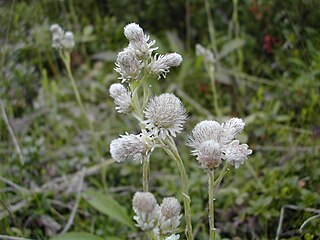
Serenoa repens, commonly known as saw palmetto, is a small palm, growing to a maximum height around 200–300 cm (6.6–9.8 ft).

Antennaria alpina is a European and North American species of plant in the family Asteraceae. Antennaria alpina is native to mountainous and subarctic regions of Scandinavia, Greenland, Alaska, and the Canadian Arctic, extending south at high altitudes in mountains in the Rocky Mountains south to Montana and Wyoming.
Spilanthes is a genus of African and South American plants in the tribe Heliantheae within the family Asteraceae.

The Heliantheae are the third-largest tribe in the sunflower family (Asteraceae). With some 190 genera and nearly 2500 recognized species, only the tribes Senecioneae and Astereae are larger. The name is derived from the genus Helianthus, which is Greek for sun flower. Most genera and species are found in North America and South America. A few genera are pantropical.

Acmella is a genus of plants in the family Asteraceae, described as a genus in 1807. It is native to the Americas and has been introduced to Asia, Africa, the Pacific islands, and Australia.
Pappobolus is a genus of flowering plant in the family Asteraceae native to the Andes Mountains of Colombia, Ecuador, and Peru.

Ambrosia acanthicarpa is a North American species of bristly annual plants in the family Asteraceae. Members of the genus Ambrosia are called ragweeds. The species has common names including flatspine bur ragweed, Hooker's bur-ragweed, annual burrweed, annual bur-sage, and western sand-bur. The plant is common across much of the western United States and in the Prairie Provinces of Canada.

Ageratina herbacea is a North American species of flowering plants in the family Asteraceae known by the common names fragrant snakeroot and Apache snakeroot. It is native to desert regions of the southwestern United States and northern Mexico. It grows in rocky slopes in conifer forests and woodlands.

Brickellia grandiflora, known by the common name tasselflower brickellbush, is a species of flowering plant in the family Asteraceae.

Ancistrocarphus filagineus is a North American species of flowering plants in the family Asteraceae, known by the common names woolly fishhooks and hooked groundstar. It is native to western North America, including Idaho, Oregon, Nevada, California, and Baja California.

Acmella oleracea is a species of flowering herb in the family Asteraceae. Common names include toothache plant, Szechuan buttons, paracress, jambu, buzz buttons, tingflowers and electric daisy. Its native distribution is unclear, but it is likely derived from a Brazilian Acmella species. A small, erect plant, it grows quickly and bears gold and red inflorescences. It is frost-sensitive but perennial in warmer climates.

Acmella uliginosa, the marsh para cress, is a species of flowering herb in the family Asteraceae. The plant is native to South America and is naturalized in parts of Asia and Africa.

Acourtia nana, the desert holly or dwarf desertpeony, is a North American species of perennial plants in the family Asteraceae. found in the Sonoran and Chihuahuan Desert regions of the south-western United States and northern Mexico.
Acmella pusilla, the dwarf spotflower, is a species of flowering herb in the family Asteraceae. The plant is native to South America and is naturalized in the southeastern United States.
Acmella pilosa, the hairy spotflower, is a Mesoamerican species of flowering plants in the family Asteraceae. It is native to Guatemala, Belize, and southeastern Mexico. The species is also naturalized in the southern part of the US State of Florida.
Boltonia apalachicolensis, common name Apalachicola doll's-daisy, is a North American species of plants in the family Asteraceae. It is found in the "panhandle" region of northwestern Florida, and has been found in south Louisiana, and Mississippi in the United States.

Hymenothrix dissecta is a North American species of flowering plants in the family Asteraceae known by the common names yellow ragweed and ragleaf bahia. It is native to the western United States as far north as the Black Hills of South Dakota and Wyoming, as well as in northern Mexico.

Ionactis caelestis, the Spring Mountain aster, is a rare North American species in the family Asteraceae. It has been found only in southern Nevada in the western United States.

Symphyotrichum anticostense is a species of flowering plant in the family Asteraceae endemic to Quebec, New Brunswick, and Maine. Commonly known as Anticosti aster, it is a perennial, herbaceous plant that may reach 10 to 90 centimeters in height. Its flowers have pale purple or lilac, sometimes white, ray florets and yellow, then reddish purple, disk florets.















